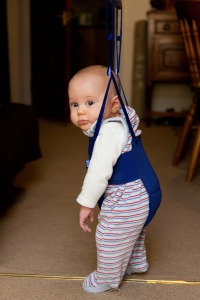Quite often I have friends and patients who ask me about walkers, exersaucers, and Bumbo seats (along with a huge list of other infant toys). There is a lot of confusing information on the internet regarding these and some of it is very misleading from manufacturers. I hope that here I can clarify some of the information and give you some facts.
The place to begin is normal child development. When a baby is born, they have no curves in their spine and they have no understanding of the physical world. These things are learned and skills are earned through experience and exploration. Motor and mental development are often broken down into “milestones” which are a series of behaviors and skills that we expect children to have at different ages.

Spinal development is completely formed through activities. Tummy time causes the little one to lift their head up, forming the cervical (neck) curve. The curve in the lumbar spine (low back) is formed when the child begins to rock and crawl. The muscles and bones of the spine develop in response to these activities and the basis of the adult spine is formed.
The same activities that help to form the curves in the spine stimulate the brain and help your child develop a sense of where they are in space (proprioception). Crawling, scooting, pulling up, walking, and tummy time help in vestibular (balance) and sensory development. Movement stimulates a circuit called the Reticular Activating System which links motion to the cerebellum and helps the brain to learn posture and balance (and a whole lot more!).
Walkers:

Walkers are one of the most dangerous babysitters. A 2006 study looked at ER data from 1991-2001 and found 197,200 ER visits related to walkers. This study does not take into account those who saw a pediatrician, other health care practitioner, or stayed home for self-care. Walkers allow little ones to move quickly and often they can tip when they encounter the edge of a rug, door sill, or staircase.
Actual physical injuries aside, it is important to take into account the mental and motor developmental delays associated with walkers. As we mentioned above, many skills are dependent upon motion and experiencing the environment. It is easy to see how a parent may think that a walker is a great way for their little one to experience the world. However, this is a false environment. In a walker, children cannot see their feet which changes how the brain develops proprioception, children do not have to learn balance, and their future gait (walking) patterns may be affected.
In 1999, a study was performed with 109 infants where some were placed in a walker and others were allowed to play on the ground. By a landslide, the walker infants sat, crawled, and walked later than the other group. It is also important to note that the walker group also scored lower on the Bayley scales of mental and motor development.
In 2004, Canada banned baby walkers.
Upright Bouncers:

Upright bouncers like the Jolly Jumper are very hard on the developing spine of the infant. The stress of being held prematurely in an upright position, when the bones and muscles have not developed the proper strength can damage the infant spine. Spondylolisthesis can occur in the lumbar spines of infants in these types of devices from the repetitive stresses delivered through an undeveloped spine. Spondylolisthesis occurs when the front part of the vertebra (which stacks) is separated from the posterior elements which surround the spinal cord and most often occurs at the lowest bone in the lumbar spine.
Exersaucers and Bumbo chairs:
These upright devices promote abnormal postures and can lead to the altered formation of the curves of the spine. For example, when an infant is placed in a Bumbo chair, their pelvis often tips backward, thrusting the ribs forward, and promoting anterior head carriage. This is a reversal of the curves we see in a normal spine- indicating that increased spinal stress is present when children sit in these positions.
While the Exersaucer is much safer (less likely to tip) than a Walker, it still promotes weight-bearing through the spine in an abnormal and premature way and should be used with caution.
What is the take home? Children need to experience their environment in order to learn. It is essential to have a lot of exploration time for our infants and little ones. The development of their brains and bodies depend upon it. As a Doctor of Chiropractic, I am committed to sharing knowledge with parents so that they can make informed decisions regarding their children.
References:
http://consults.blogs.nytimes.com/2010/02/22/the-dangers-of-baby-walkers/?_r=0
https://www.ncbi.nlm.nih.gov/pubmed/10533994
https://www.ncbi.nlm.nih.gov/pubmed/16510623
http://pathwaystofamilywellness.org/The-Outer-Womb/maximizing-infant-development.html



 This morning the last thing I wanted to do was put on my running shoes and hot the trails…but I did anyway.
This morning the last thing I wanted to do was put on my running shoes and hot the trails…but I did anyway.